 Identifying Conics by the Discriminant (Part 1)
Identifying Conics by the Discriminant (Part 1)
(This page is Part 1. Click here for Part 2.)
Conic sections—circles/ellipses, parabolas, hyperbolas—were introduced in the prior section. They arise by intersecting a plane with the surface of an infinite double cone.
In this current section, we begin the analysis of equations representing conic sections.
There are results in this section for which you might be wondering: Why is this true? If so, then you're encouraged to study the following optional sections:
- Intersecting an Infinite Double Cone and a Plane: Looking at the Equations
- How is it that the Conic Discriminant tells us the Type of Conic?
General Conic Equation
Let $\,A\,,$ $\,B\,,$ $\,C\,,$ $\,D\,,$ $\,E\,$ and $\,F\,$ be real numbers.
Consider the equation:
The $\,x^2\,,$ $\,xy\,$ and $\,y^2\,$ terms are often called the degree-two terms in this equation. Why? Because the exponents are $\,2\,,$ or they add to two:
There is a beautiful relationship between equations of this type and the graphs of conic sections! Indeed, both of the following are true:
- Given any equation of the form ($\,\dagger\,$), it graphs as a conic, a degenerate conic, or a curve that arises from a ‘limiting case’ of an infinite double cone (discussed below).
- Given the graph of any conic section, drawn anywhere in an $\,xy\,$-plane, it can be described by an equation of the form ($\,\dagger\,$).
For this reason, ($\,\dagger\,$) is called the general conic equation.
If the (nonzero) terms are in precisely the same order as indicated in ($\,\dagger\,$), with zero on the right-hand side, then the general conic equation is said to be in standard form.
(By the way, the symbol ‘$\,\dagger\,$’ is a ‘dagger’, and is often used to mark an important equation.)
When you're ‘on the lookout’ for conics, you certainly don't need the equation to be in standard form! Just check that there are no term types other than $\,x^2\,,$ $\,xy\,,$ $\,y^2\,,$ $\,x\,,$ $\,y\,$ and constants. Any of the coefficients can equal zero, so you might not have all these term types.
It's not particularly easy to go from an arbitrary equation of the form ($\,\dagger\,$) to its graph, using paper-and-pencil. (In the next few sections, you'll learn to graph fairly simple conics.) However, WolframAlpha is up to the task! If you're bored, jump up there, type in a random general conic equation, and see the awesomeness of WolframAlpha!
Here are some WolframAlpha results to illustrate the variety of conic sections (including some degenerate and limiting cases). You can cut-and-paste the equations below each graphic into WolframAlpha yourself to verify the results. Enjoy!
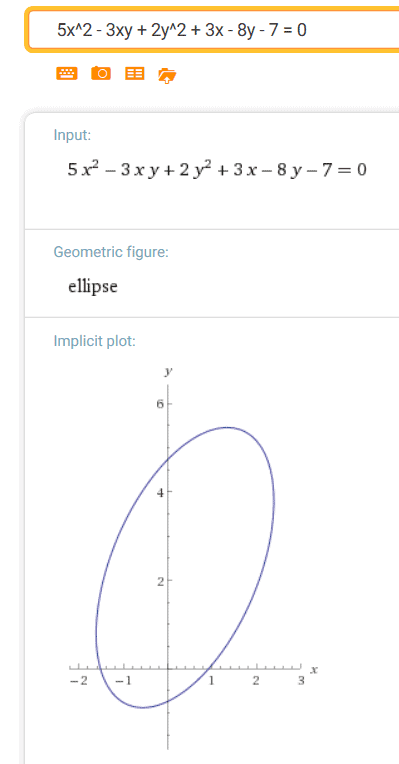
5x^2-3xy+2y^2+3x-8y-7 = 0
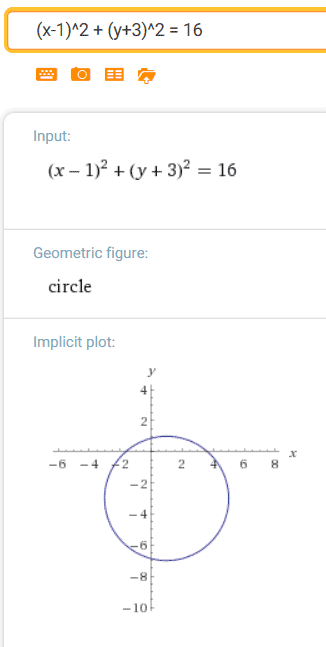
(x-1)^2 + (y+3)^2 = 16
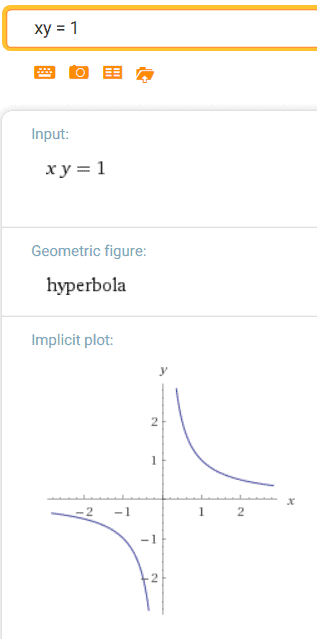
xy = 1
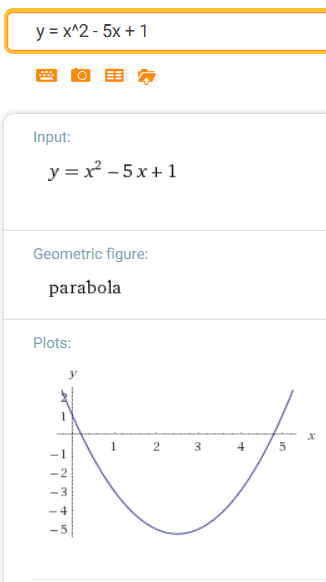
y = x^2 - 5x + 1
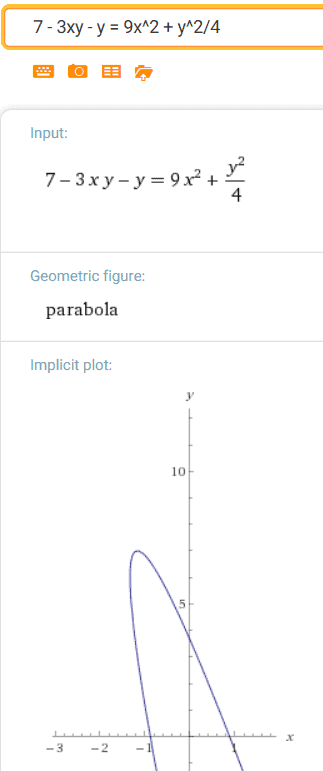
7 - 3xy - y = 9x^2 + y^2/4
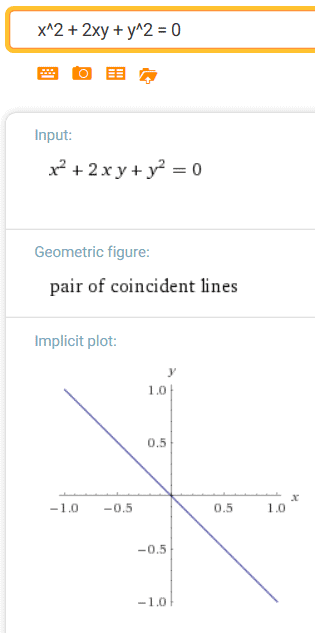
x^2 + 2xy + y^2 = 0
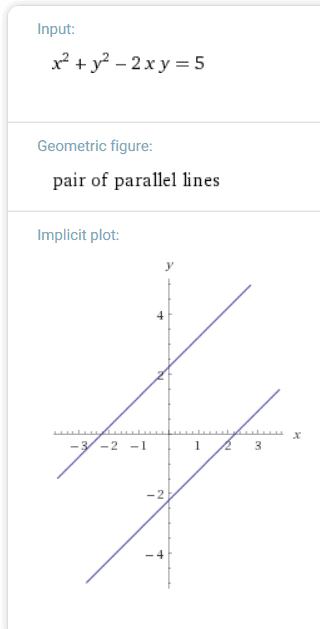
x^2 + y^2 - 2xy = 5
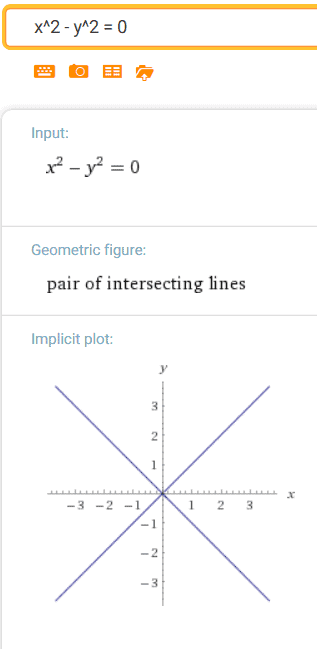
x^2 - y^2 = 0
Use the sliders to set the desired values for the parameters $\,A\,,$ $\,B\,,$ $\,C\,,$ $\,D\,,$ $\,E\,,$ and $\,F\,.$
You can use the navigation arrows at the bottom right to see more of the graph. Enjoy!
Conic Discriminant
Even though conics can be challenging to graph, here's some really good news. There's a simple way to decide which type of conic is represented by a given general conic equation, as follows:
Read off the coefficients $\,A\,,$ $\,B\,$ and $\,C\,$ from ($\,\dagger\,$).
Note: As long as all the degree-two terms are on the same side of the equation, then:
- $A\,$ is the coefficient of the $\,x^2\,$ term
- $B\,$ is the coefficient of the $\,xy\,$ term
- $C\,$ is the coefficient of the $\,y^2\,$ term
Compute $\,B^2 - 4AC\,,$ which we'll call the conic discriminant. (In context, it will more simply be called the discriminant.)
Use the table below to determine the type of conic represented by the equation:
| Conic Discriminant | $B^2 - 4AC \lt 0$ |
| Type of Conic Section |
Ellipse (possibly degenerate)
If, in addition, $\,A = C\,,$ then it's a circle. |
| Possible Memory Device |
Look at the letters in the word ellipse!
There's an L.
There's an E.
There's an S.
It practically spells out
‘less’!
When the discriminant is less than zero, it's an ellipse. |
| Conic Discriminant | $B^2 - 4AC = 0$ |
| Type of Conic Section | Parabola (possibly degenerate) |
| Possible Memory Device | (no memory device) |
| Conic Discriminant | $B^2 - 4AC \gt 0$ |
| Type of Conic Section | Hyperbola (possibly degenerate) |
| Possible Memory Device |
If you're hyper,
then you have a great deal of energy.
When the discriminant is GREATer than zero, it's a HYPERbola. |
The expression $\,B^2-4AC\,$ is called the discriminant because it helps us discriminate (differentiate) between the different types of conics.
Note the similarity to the discriminant of a quadratic equation $\,ax^2 + bx + c = 0\,.$ The quadratic discriminant is $\,b^2 - 4ac\,,$ and helps us decide how many real solutions the quadratic equation has.
Examples: Using the Discriminant to Determine the Type of Conic
Example 1: General Conic Equation in Standard Form
(from the WolframAlpha example above).
and compute the discriminant:
Example 2: General Conic Equation Not in Standard Form
Consider the equation $\,y = x^2 - 5x + 1\,.$ It's a general conic equation, but it's not in standard form.
From prior mathematical experience, you know that quadratic functions graph as parabolas. However, let's check that the ‘conic discriminant’ gives the same information.
You could put the equation in standard form: either
or
In the first way, you'd read off $\,A = 1\,$ and $\,B = C = 0\,.$ In the second way, you'd read off $\,A = -1\,$ and $\,B = C = 0\,.$
But, there's an easier thought process. Just check that the degree-two terms are all on the same side of the equation. For the equation $\,y = x^2 - 5x + 1\,,$ there's only one degree-two term ($\,x^2\,$), so the side it's on doesn't matter. So, $\,A = 1\,$ and $\,B = C = 0\,.$
In all cases, $\,B^2 - 4AC = 0\,.$ The discriminant equals zero—it's a parabola.
Example 3: A Degenerate Conic—a ‘Point Circle’
Consider the equation $\,x^2 + y^2 = 0\,.$ The only point that makes this equation true is $\,(x,y) = (0,0)\,.$
Read off $\,A = 1\,,$ $\,B = 0\,,$ and $\,C = 1\,.$
Since the discriminant is negative, it's an ellipse. Since, in addition, $\,A = C\,,$ it's a circle. (A circle is a special case of an ellipse.)
This is a degenerate case: a circle of radius zero, fondly called a ‘point circle’.
Example 4: A Hyperbola
Consider the equation $\displaystyle\,y = \frac 1x\,.$
In this equation, $\,x\,$ is not allowed to equal zero. With $\,x \ne 0\,,$ multiplying both sides by $\,x\,$ gives $\,xy = 1\,,$ which is now recognizable as a conic.
In the equation $\,xy = 1\,,$ we have $\,A = C = 0\,$ and $\,B = 1\,.$ Thus, $\,B^2 - 4AC = 1 \gt 0\,.$
Since the discriminant is positive, it's a hyperbola. The familiar reciprocal function is a hyperbola.